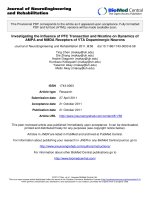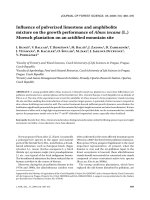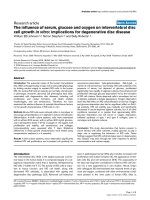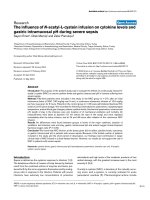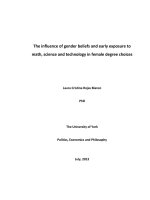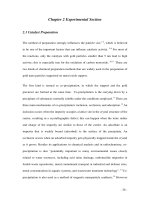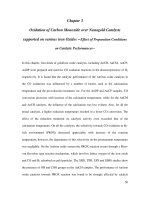The influence of perceived price and physical environment on customer satisfaction a study on coffee at doi chaang caffé motorway (outbound) in thailand
Bạn đang xem bản rút gọn của tài liệu. Xem và tải ngay bản đầy đủ của tài liệu tại đây (600.08 KB, 85 trang )
ASSUMPTION UNIVERSITY OF THAILAND
Graduate School of eLearning
THE INFLUENCE OF PERCEIVED PRICE AND PHYSICAL ENVIRONMENT ON
CUSTOMER SATISFACTION: A STUDY COFFEE OF DOI CHAANG CAFFÉ
MOTORWAY (OUTBOUND) IN THAILAND
BY
PIYAWAN DUMRONGPIRIYAKUN
MS 7004 Independent Study
Submitted in Partial Fulfillment of the Requirements for the Degree of
Master of Science in Management
Jun 2017
Research Title:
Author:
Advisor:
Degree:
Year:
The influence of perceived price and physical environment on
customer satisfaction: A study on coffee at Doi Chaang Caffé
Motorway (outbound) in Thailand.
Piyawan Dumrongpiriyakun
Assoc. Prof. Dr. Varughese K. John
Master of Science in Management
2017
Abstract
The purpose of this study is to determine the influence of perceived price
and physical environment towards customer satisfaction on coffee at Doi Chaang
Caffé Bangkok-Chonburi Motorway (outbound) in Thailand.
Data were collected at Doi Chaang Café Motorway (outbound) branch
using online and self-administered questionnaires. The samples were selected
using convenience sampling and snowball techniques. A total of 395 complete
and valid questionnaires were collected from self-administered and online
questionnaires.
Both perceived price and physical environment have a positive influence
on customer satisfaction at Doi Chaang Caffé Motorway branch; however, the
physical environment has a stronger impact on customer satisfaction.
This paper is useful for café marketers to understand the effect of both
variables in order to maximize customer satisfaction and enhance profitability.
Keywords: Perceived Price, Physical Environment, Customer Satisfaction,
Coffee shop and café industry.
1
Acknowledgement
I’m fortunate to have many instructors for the support of this study. I have
greatly benefitted from the advice of Assoc. Prof. Dr. Varughese K. John, my
advisor, and through the guidance of Dr. Piyathida Praditbatuga, the Program
Director.
It is with great pleasure that I acknowledge the supportive comments of
the committee members Assoc. Prof. Dr. Grai Phongam and Dr.Thanawan
Phongsatha. The study would not be successful and complete without their
comments and suggestions. Furthermore, I am grateful to Dr. Satha Phongsatha
for his guidance through the research workshop.
I am greatly obliged to the management of Doi Chaang Caffe Motorway
(outbound) branch for their cooperation and assistance in collecting data from
their customers.
Definitely, no list of acknowledgment would be complete without
expressing a word of thanks to my friends and classmates who have assisted,
motivated, and been involved in this study. I wish to thank everyone who has
given me great support throughout this study.
2
Table of Contents
Abstract ............................................................................................................................... 1
Acknowledgement .............................................................................................................. 2
Table of Contents ................................................................................................................ 3
List of Tables ...................................................................................................................... 5
List of Figures ..................................................................................................................... 5
CHAPTER 1 INTRODUCTION ....................................................................................... 6
1.1 Background of the Study .......................................................................................... 6
1.2 Background of Doi Chaang Caffé............................................................................. 7
1.2 Statement of the Problem .......................................................................................... 8
1.3 Research Objective ................................................................................................. 10
1.4 Research Question .................................................................................................. 11
1.5 Significance of the Research ................................................................................... 11
1.6 Scope of the Research ............................................................................................. 12
1.7 Limitation of the Research ...................................................................................... 13
1.8 Definitions of Terms ............................................................................................... 14
1.9 Organization of Research Chapters......................................................................... 15
CHAPTER 2 LITERATURE REVIEW .......................................................................... 16
2.1 Overview of Coffee Shops Industry........................................................................ 16
2.2 Theoretical Foundation ........................................................................................... 18
2.2.1 Perceived Price................................................................................................. 18
2.2.2 Physical Environment ...................................................................................... 20
2.2.3 Customer Satisfaction ...................................................................................... 22
2.3 Previous Related Research ...................................................................................... 25
2.4 Conceptual Framework ........................................................................................... 32
2.5 Research Hypothesis ............................................................................................... 33
2.6 Operationalization of Variables .............................................................................. 34
3
CHAPTER 3 RESEARCH METHODOLOGY .............................................................. 36
3.1 Research Design...................................................................................................... 36
3.2 Population and Sample ........................................................................................... 37
3.3 Research and Measuring Instrument ....................................................................... 40
3.4 Pretest, Reliability Test ........................................................................................... 41
3.5 Collection of Data ................................................................................................... 43
3.6 Data Processing and Analysis ................................................................................. 44
CHAPTER 4 DATA ANALYSIS AND RESULTS....................................................... 45
4.1 Reliability Test ........................................................................................................ 45
4.2 Profile of the Respondents ...................................................................................... 46
4.3 Mean Evaluation of Variables................................................................................. 48
4.4 Hypothesis Testing.................................................................................................. 52
CHAPTER 5 CONCLUSION AND RECOMMENDATIONS ...................................... 56
5.1 Summary of the Research ....................................................................................... 56
5.2 Discussion of the Research Finding ........................................................................ 57
5.3 Answer to Research Question ................................................................................. 59
5.4 Implication for Practice........................................................................................... 60
5.5 Recommendation for Future Research .................................................................... 61
REFERENCES................................................................................................................ 63
APPENDIX A: QUESTIONNAIRES ............................................................................ 67
APPENDIX B: RELIABILITY TEST ............................................................................ 73
APPENDIX C: DESCRIPTIVE STATISTICS .............................................................. 78
APPENDIX D: REGRESSION ANALYSIS ................................................................. 81
APPENDIX E: LIST OF THE TOP COFFEE CONSUMPTION BY NATION .......... 83
4
List of Tables
Table 2.6 Operational Definition of Variables
Table 3.1 Values of z for 95% and 99% Level of Confidence
Table 3.2 Coefficient Alpha (α) and Reliability Indication
Table 3.3 The Result of the Reliability Measurement Pretest
Table 4.1.1 Reliability of the Measurement Scale
Table 4.2.1 Profile of the Respondents
Table 4.3.1 Arbitrary Level of variables, Mean Score Range and Interpretation
Table 4.3.2 Descriptive Statistic of Perceived Price
Table 4.3.3 Descriptive Statistic of Physical Environment
Table 4.3.4 Descriptive Statistic of Customer Satisfaction
Table 4.4.1 Summary of SLR and Hypotheses Testing Results
Table 5.2.2.1 Summary Item Means of Variables and Interpretation
List of Figures
Figure 1: Conceptual Framework
5
CHAPTER 1 INTRODUCTION
1.1 Background of the Study
Coffee is booming in Bangkok. Given that coffee shops have become
today’s new trend, Dunne et al. (2010) suggested that key elements in marketing
include price, store lay out design, merchandise, promotion, people, and customer
service. Kotler and Keller (2009) argue for an integrated approach, indicating that
shop’s marketing decisions involve target market, product, service provided by
store atmosphere, price, place, promotion, and personnel. American Marketing
Association presidential address coined the term, "marketing mix", in 1953.
Marketing Mix’ is also referred and known as the Four P's i.e. product, price,
place of distribution, and promotion. These are the primary ingredients of a
marketing strategy, and as a means of translating marketing planning into
practice. McCarthy (1960) was first to suggest the four P's. Price and place of
distribution are part of the fundamental concept of marketing mix, which is the set
of controllable marketing variables that the firm blends to produce the response it
wants in the target market.
In the field of marketing there are various aspects of interests like
products,
prices,
places,
persons,
services,
events,
promotions,
ideas,
communication, etc. This study has focused on the influences of the two
dimensions of marketing, namely perceived price and physical environment, to
6
achieve highest customer satisfaction and with the purpose of bringing traffic into
the café as well as increasing market share and profitability in the long run.
The Bangkok-Chonburi outbound area is an extremely competitive area in
regards to coffee shops and the café business a whole; marketers crucially need to
understand about their customers’ satisfaction and need to adopt strategies to
remain competitive in their business.
1.2 Background of Doi Chaang Caffé
Doi Chaang Coffee is the Royal Projects initialed by His Majesty King
Bhumibol Adulyadej after his first visit to Hmong villages in 1967. The King
decided that the hill tribes should stop growing poppies for opium. Starting from
the small village of Doi Chaang, the home of an Akha hill tribe at Chang Rai
province in the North of Thailand, Arabica is grown and produced by the Akha
hill tribe famers in the Golden Triangle Mountains where the climate, soil
composition, and geographical position were in optimal balance to produce
world-class coffee.
In Thailand, there are total 22 franchisees of Doi Chaang Caffés including
7 branches located in Bangkok and nearby.
1. Doi Chaang Caffé Motorway (outbound)
2. Doi Chaang Caffé (Kwan Riam Floating Market)
7
3. Doi Chaang Caffé (Bank for Agriculture and Agricultural Cooperatives,
Bang Khen)
4. Doi Chaang Caffé (Sai Noi)
5. Doi Chaang Caffé (Thai Airways Head Office)
6. Doi Chaang Caffé (Don Muang Airport)
7. Doi Chaang Caffé (Laksi)
Around 300 Doi Chaang coffee shops throughout Thailand purchase
coffee beans and rent a logo from Doi Chaang’s company. However, most of the
coffee shops in Thailand have not been yet renewed to be a franchisee under Doi
Chaang Master, the franchiser. The finest coffee bean from Doi Chaang is a
single-estate 100% Arabica, which is grown and produced by a north-eastern
Thailand hill tribe known as the “Akha” in the Golden Triangle mountains in the
Chiang Rai Province. They sell their beans in Thailand as well as export to Japan,
Australia, Canada, and is also now available at Harrods’s, London.
1.2 Statement of the Problem
To survive in an intensively competitive environment such as the
Motorway outbound area, it is vital that the marketer understands customer
satisfaction. In order to gain a competitive advantage in today’s market, offering
good products and services is not enough to attract and retain customers. In the
highly competitive coffee shop and café business at the meeting point around the
8
Motorway outbound area, what are the hottest marketing strategies for ensuring
success in attracting customers into the café and increasing its sales? Special
consideration must be given to accomplishing this through the use of pricing,
physical environment strategies, and gaining highest customer satisfaction in the
long term. Kotler (2009, pp 425) indicated that price has operated as the major
determinant of buyer choice. Consumers often process interpreting prices from
purchasing experience and point of purchase. Non-price factors such as point-ofpurchase, where the products and services are delivered, has become a more
important element in determining customer satisfaction, which consequently
brings more traffic to the café and increases market share as well as profitability.
How do cafés survive in this highly competitive market in that zone? And
how do cafés achieve customer satisfaction? The primary key is to understand
what creates customer satisfaction. The marketers should emphasize delivering
satisfaction to consumers in order to create positive word-of-mouth, which will
result in repeat sales and increases in return profit.
Perceived price is the encoded price by the consumer (Zeithaml 1988).
Prices are often set to satisfy demand or to reflect the willingness to pay for
product or services by the customer. Price is one of the elements in the marketing
mix (Product, Price, Place and Promotion) determining market share and
profitability. Perhaps, price is the easiest element of the marketing program to
adjust and takes a shorter time than other elements such as product features,
channels, or even promotion (Kotler, 2009).
9
Another important factor that has the ability to attract and satisfy
customers is atmosphere, which has recently received a lot more attention among
scholars (Han, Ryu 2009; Namkung and Jang, 2008). Empirical studies in
consumer research confirm that background characteristics of the environment
such as décor, ambient condition, furniture, music, scent, and lighting may
influence length of stay in a restaurant (Bitner, 1992; Han, Ryu 2009). Positive
responses to the environment of a place play a significant role in the desire to stay
and affiliate (Han, Rye 2009). Marketers should not neglect atmosphere as it is an
attractive marketing tool (Kotler 1973-1974) and can lead to more spending at the
café.
1.3 Research Objective
There are two specific objectives of this study:
1. To determine whether the perceived price has an influence on customer
satisfaction of coffee at Doi Chaang Caffé Motorway (outbound) in Thailand.
2. To determine whether the physical environment has an influence on customer
satisfaction of coffee at Doi Chaang Caffé Motorway (outbound) in Thailand.
10
1.4 Research Question
The following research question was formulated to explain the statement
of the problem of this research,
1. Does perceived price has significant influence on customer satisfaction
of coffee at Doi Change Caffé Motorway (outbound) in Thailand?
2. Does physical environment has significant influence on customer
satisfaction of coffee at Doi Change Caffé Motorway (outbound) in Thailand?
1.5 Significance of the Research
The number of frequent coffee drinkers and coffee consumption in
Thailand is increasing. The key factor driving sales of coffee in Thailand in 2015
was the development of the coffee culture. ( Bangkokpost.com published that for the new generation,
drinking coffee in a warm and comfortable atmosphere is appealing. In Thailand,
sophisticated coffee culture is gradually emerging. Twenty years ago, modern
coffee drinking style emerged in tandem with the Black Canyon chain, followed
by Starbucks in 1998. The question is whether they just like the experience they
get from sitting in that café, or is it derived from buying coffee at reasonable
prices.
11
Customer satisfaction is strongly influenced by perceived price and
physical environment, as cited by Heesup Han and Kisang Ryu (2009). This
study will provide a better understanding of how these two factors influence
customers’ satisfaction and support the decision maker to develop marketing
plans and strategies to maximize customer satisfaction and increase profit.
1.6 Scope of the Research
The target population includes all customers who drink coffee at Doi
Chaang Caffé Motorway Bangkok-Chonburi (outbound) branch. This research
aims to investigate satisfaction of customers who sit in and drink coffee at the
café and determine the factors of perceived price and physical environment
towards customer satisfaction of Doi Chaang Caffé.
The exact number of
customers of Doi Chaang Caffe Motorway (outbound) cannot be identified;
therefore the formula for unknown number of population was applied, and
required at least 385 complete and valid questionnaires to be collected for
analysis, as this number was sufficient to represent the whole population
(Berenson, 1999). The questionnaire collection period for the study was
December 24, 2016 – February 15, 2017.
12
1.7 Limitation of the Research
This research studied the customers of Doi Chaang Caffé Motorway
Bangkok-Chonburi (outbound) branch only; therefore, the results of this research
may not be applicable to customer satisfaction of other Doi Chaang branches or
other coffee shops in general.
Since the respondents may be confused about the distinction between Doi
Chaang Caffé Motorway (outbound) branch, which is a franchisee, and other Doi
Change Coffee Shops that are not franchisees but merely rent a logo and use
coffee from Doi Chaang in their own recipes. Extreme care should be taken while
collecting data from respondents for this type of study because of the chance of
overlapping between these two types of customers. Therefore, self-administrative
questionnaires were conducted exclusively at Doi Chaang Caffé Motorway
(outbound) branch.
This research examined only two selected variables, which were perceived
price and physical environment. Hence, it did not cover the other variables of
marketing mix such as products, persons, services, events, promotions, ideas, and
communication, which might also have influence on customer satisfaction.
13
1.8 Definitions of Terms
Perceived Price is what consumers consider to be the current actual price, not
the marketer’s stated price. (Kotler, 2009).
Physical Environment is interior design, décor, music, cleanliness, and
employees’ neatness and appearance (Kisang Ryu, Hye-Rin Lee, Woo Gon Kim,
2012).
Customer Satisfaction is the excellent overall consumption experience at a
particular place, (Kisang Ryu, Hye-Rin Lee, Woo Gon Kim, (2012).
Doi Chaang Coffee is a specialty coffee, single origin, and high quality
Arabica Coffee.
Doi Chaang Caffé is the official name of the franchise outlets or franchisees
Doi Chaang Franchise is a B2B, or business-to-business, networking to
support DOI CHAANG Caffè or franchisees for both operation and management
levels.
14
1.9 Organization of Research Chapters
Chapter 1 Introduction: This chapter provides a broad overview of the research.
This chapter consists of a background of the study, statement of the research
problem, research objective with research question, significance of the research,
scope of the research, limitation of the research, definition of key terms, and
organization of the research study.
Chapter 2 Literature review: This chapter provides an overview of the coffee
shop business in Thailand and Southeast Asia; a review of the literatures relevant
to each variable of the conceptual model (perceived price, physical environment
and customer satisfaction); and related theoretical frameworks, research, and
hypotheses.
Chapter 3 Research methodology: This chapter includes the methodology
adopted in the study. It includes the research design, population, sample size,
research instrument and data collection, and statistical techniques used to test the
hypotheses.
Chapter 4 Data analysis and Result: This chapter describes the data analysis
and the interpretation of the results.
Chapter 5 Conclusion and Recommendations: This chapter includes the
summary of the findings and provides recommendations for future research, based
on the results of the study.
15
CHAPTER 2 LITERATURE REVIEW
2.1 Overview of Coffee Shops Industry
The number of frequent coffee drinkers as well as the amount of coffee
consumption is increasing, as reported by euromonitor.com (Coffee in Thailand,
Feb. 2016). The key factor that drove coffee sales in Thailand in 2015 was the
development of consumer behavior. Thai consumers were finding more ways of
enjoying coffee other than consuming coffee as a stimulant in the morning or
during the working day. Bangkokpost.com published “Cafe culture in Asian
countries, 2014” and views the development of a coffee culture in different
waves. The first wave is when coffee is introduced to the market in the form of
mass-produced brews. The second wave focuses on tastes and roasting styles,
bringing “espresso beverages” to the menu via coffee chains such as Starbucks.
The third wave is when coffee becomes more of a craft, emphasizing the quality
and origin of the beans. Thailand is moving onto the third-wave of coffee culture
where coffee is all about the flavor, introducing coffee drinkers to baristas and to
bean growers.
Sophisticated coffee culture is gradually emerging in Thailand, whereas
traditional coffee and instant coffee was widely consumed in the past. Twenty
years ago the turning point towards a more modern coffee drinking style occurred
when the Black Canyon chain emerged, followed by Starbucks in 1998.
16
( For younger generations, drinking
coffee in the warm, comfortable ambiance of a foreign coffee shop is tempting.
The question posed by Bangkokpost.com was whether they really like the taste of
coffee or just like the experience they get from sitting in that café. In my opinion,
it’s interesting to find out the answer in future research.
The coffee shop chains changed consumer behavior, making coffee the
beverage of choice in the morning hours. This particular trend triggered higher
and higher coffee consumption in Thailand. Thai consumers now purchase coffee
as their favorite daytime drink as well as to stimulate them and keep them awake
at night ( />The behavioral change of Thai people to more a westernized lifestyle can
be witnessed from the expansion of coffee stalls and coffee stores chains
nationwide. In 2007 alone, four new foreign players, namely McCafe, Segafredo,
Gloria Jean’s, and Cafe Ritazza entered the market to reap the benefits of the
growth in coffee consumption. After that, different types of coffee shops were
opened, including boutique coffee shops along Sukhumvit road, local coffee
shops chains such as True coffee and Cafe Amazon, and street-side coffee kiosks.
( />According to the report on the Southeast Asian coffee shops, Asian café
growth is accelerating. China is the leading Southeast Asian coffee shop market,
with an estimated 5,391 outlets. Thailand is the second largest market by number
17
of stores with 2,775 outlets. The Thai market as a whole grew by 7%, adding 168
outlets during 2015. The third largest market by size is Taiwan, with 1,730
branded chain outlets and a growth of 5% since 2014. Stir-tea-Coffee.com
reported that intensive competition has made market conditions challenging in
Thailand; an example of this is that brands must compete with Café Amazon and
Starbucks, which are all firmly established in the market.
(http://stir-tea-
coffee.com/features/asian-caf%C3%A9-growth-accelerates/)
To be successful, café and coffee shops should differentiate themselves
and move towards the third wave of coffee culture. Café or coffee shops should
offer an innovative experience by providing fine decor, comfortable seats, Wi-Fi,
unique food offerings, a variety of beverages, and appropriate and reasonable
prices. ( />
2.2 Theoretical Foundation
2.2.1 Perceived Price
Perceived Price is what the customer has given up or sacrificed to
obtain a product or service, price is distinguished as objective price and perceived
price, (Zeithaml, 1988). While objective price is the actual price tag for the
product/service, perceived price indicates the price as encoded by the customer
that involves thinking and evaluation, in contrast to emotional feeling, as cited by
18
Dev Jani Heesup Han (2011). A key role in indicating customer satisfaction is
price and it also has the ability to attract or repel customers (Fornell, 1996). Price
is what the customer is giving up or sacrificing in order to obtain a product or
service, price is distinguished as objective price (the actual price of product) and
perceived price (encoded price by the consumer); Zeithaml (1988). Actual price is
the tagged price of a product or service, and then customers will compare and
encode the objective price into perceived price (Zeithaml, 1984; Jani, Han 2011).
Consumers always encode prices in ways that are meaningful and usually
remember encoded prices instead of the actual price of products (Zeithaml, 1984).
According to Zeithaml’s (1988) relating price model, objective price is less
encompassing than perceived price.
Consumer psychology and pricing published in Marketing Management
“An Asian Perspective” (Kotler, 5th edition, 2009, p.425) stated that marketers
recognize that consumers often actively process price information, interpret and
compare price from prior purchasing experiences, process both formal and
informal communicating (advertising, brochures, friends, colleagues, or family
member), and point-of-purchase.
Price is an important antecedent of customers’ satisfaction as consumers
depend on price because it is extrinsic signal of quality (Kaura, 2012). Han, Ryu
(2009) found that perceived price has significant influence on customer
satisfaction in Korea’s restaurant industry, when customers perceive a reasonable
price their satisfaction in the product can be increased. Di, R and U Ramanathan
19
(2016) concluded from the restaurant study that price, ambience, product, and
service are significant factors of customer satisfaction. Perceived price is an
important determinant of post purchase behavior; customer judge and pay based
on perceptions of what is received, such as products and services, and when
customer perceive that pricing is reasonable, their satisfaction will increase
(Rye,Han 2010).
2.2.2 Physical Environment
Customers consciously and unconsciously sense the physical environment
(Ryu, Han 2010). Buyers respond to the total products (goods and service) and
one of the most importance features that accompany the product is the place
where it is bought or consumed (Kotler, 1973-1974). Reported by Namkung and
Jang (2008), key attributes of physical environment (fascinating interior design,
color, pleasing background music and layout), food taste, and service of
employees are important attributes in contributing to the high satisfaction in the
restaurant industry.
Bitter (1992) revealed the factors that facilitate the achievement of
marketing goals (in terms physical environmental dimensions) such as ambient
condition, ambient condition include background characteristics of the
environment such as music, furnishing, style of décor, lighting, temperature. The
physical environment’s ability to influence behaviors and create an image is
20
particularly apparent for service businesses such as hotels and restaurants, as cited
by Bitner (1992).
Customer and employees’ behavior is strongly impacted by physical
surroundings and environment dimensions (Bitner, 1992). Customer satisfaction
is a primary objective and has become the greatest interest of marketing strategies
(Namkung and Jang, 2008; Zhang Ziqiong Zhang Zili Law Rob, 2013). Pleasing
surroundings such as décor, music, and cleanliness may determine the level of
overall customer satisfaction (Ryu, Han 2010; Woo Gon Kim 2012).
In the restaurant industry today, the most important factors are design and
concept, whilst the least important thing is the food (Soriano, 2002). Surroundings
such as design, decoration, background music, cleaning and grooming of service
providers creating and maintaining a distinctive atmosphere, and pleasant physical
environment might determine customers’ overall satisfaction to a large extent
(Ryu, Han 2010).
The study undertaken by Han and Rye (2009) indicated that
Décor was the most significant predictor of price perception among the three
components of the physical environment (décor, ambient conditions, spatial
layout); when customers feel that the physical environment reflects quality (e.g.
interior design and décor, pleasant music) their level of satisfaction would also
increase.
Physical environment has garnered much attention among scholars and
marketers as it is one of the key factors that attracts attention whilst also creating
21
imagery and satisfaction, which consequently increases the traffic of the shops
and leads to increases in income and market share (Kotler, 1973-1974; Ryu, Han
2010; Bitner 1992).
2.2.3 Customer Satisfaction
Customer satisfaction is frequently used as an indicator of repeat or return
customers (Soriano 2002; Han, Rye 2011). Consumer satisfaction (CS) is a
central concept in modern marketing thought and practice (Yi, 1993). Han, Ryu
(2009) suggested that an overall judgment process of the perceived discrepancy
between prior expectation and actual consumption is considered as customer
satisfaction. Overall satisfaction is based on overall experience, and it is a
summary evaluation of the entire product consumed in a single experience, not
the cumulative satisfaction (Spreng, MacKenzie, & Olshavsky 1996; Chih-Hsing
Liu Sheng-Fang Chou Bernard Gan Jin-Hua Tu, 2015). Obtaining customer
satisfaction means that customers repeat the experience served and become an
effective and efficient communication resource, at no cost to the firm (Marta,
2004). Customer satisfaction or dissatisfaction affects the buying decision of
customers towards the same company in the future (Engel, Blackwel and Kollat,
1968). Di and R & U Ramanathan’s study (2015) on the restaurant industry found
that the most significant factors that influence customer satisfaction, in order of
22
rank, are products (e.g. food quality), price (e.g. worthy price), ambience (e.g.
cleanliness), and service.
In order to understand the level of customer satisfaction, marketers need to
understand the buying decision process of their customers. Engel, Blackwel and
Kollat (1968) studied consumer behavior and proposed a 5-staged framework to
evaluate customer’s buying decision process; however, the stages do not need to
be proceeded through in numerical order. The 5 stages are:
1. Problem/ Need recognition: Needs theory in psychology proposed by
Abraham Maslow in 1943, the need is triggered by internal stimuli (e.g. hunger,
thirst) or external stimuli. External stimuli can be aroused and tempted by using
advertisement, attractiveness of product and service, price, point of purchase, and
promotion.
2. Information search: Consumers getting information and considering
availability of products or services, or other related buying decision such as prices
and marketing activities. This decision will fit their needs and provide the greatest
level of satisfaction, feeling, or the best solution.
3. Evaluation of alternatives: Consumers compare and evaluate available
alternatives based upon the attributes of the different of product or service: price
assigned on products, point of purchase, or physical environment.
4. Purchase decision: After an evaluation of the alternatives, consumers
then make a purchase decision of whether to buy or not. Purchasing decision is
23
based on perceived prices, not the marker’s stated price (Kotler,5th
edition,2009,p.425). Purchase decision often indicates whether there is customer
satisfaction or not. For example, Han and Ryu (2009) found that physical
environment strongly influenced how customers perceived price and that this
price perception, in turn, increased the level of customer satisfaction.
5. Post-purchase behavior: After purchase action, customers compare
products with their perception and the results are either satisfied or dissatisfied.
The customer will spread either positive or negative feedback.
Canny, I. U. (2014) and Ryu,Han 2010 reveled that satisfied customers
will perform behavioral intentions such as revisit, say positive feedback, and/or
recommend to others. Customer satisfaction is usually defined in the literature of
marketing as a customer’s overall evaluation of their purchase and consumption
experience (Namkung and Jang, 2008).
According to Ryu and Han’s (2010) study of restaurants in Korea,
perceived price and physical environments are important determinants that have
the ability to increase level of satisfaction.
In this research study, customer satisfaction shall be tested for both
elements under the study: perceived price and physical environment.
24

